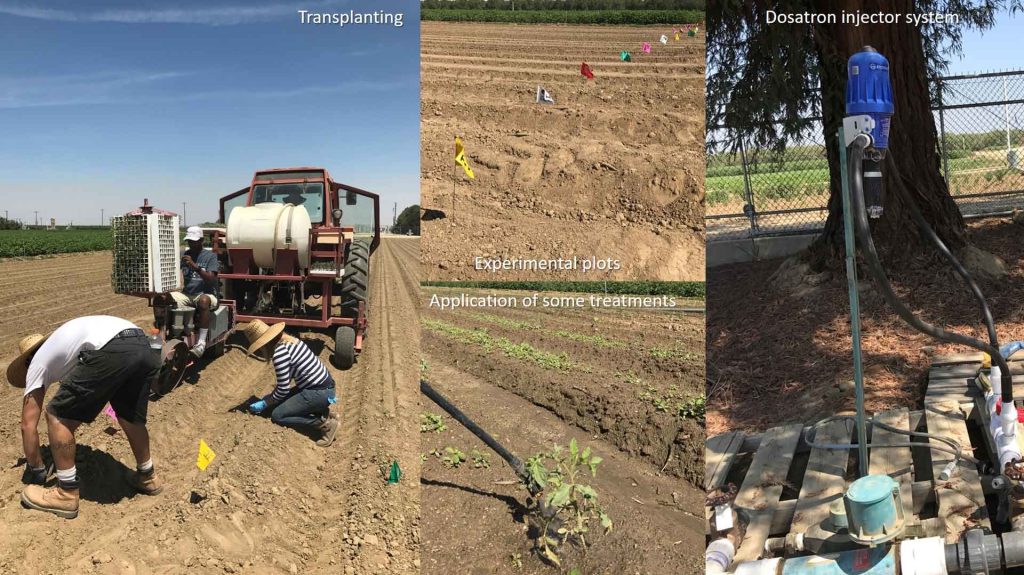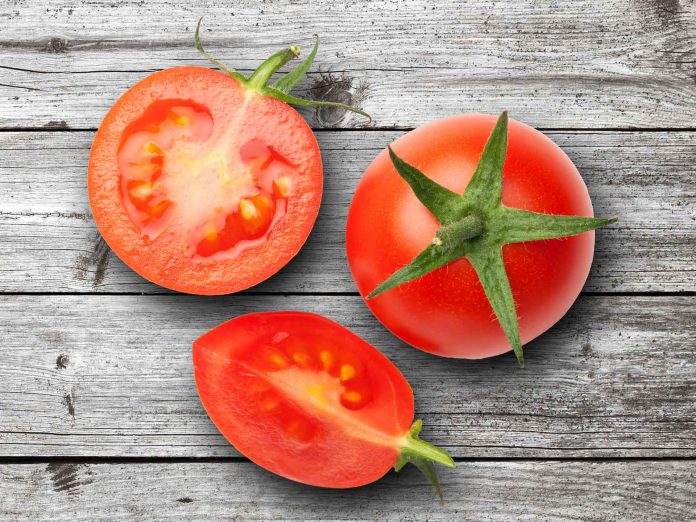California is the leading producer of tomatoes, especially for the processing market (California Department of Food and Agriculture (CDFA), 2019). Tomato is the 8th most important commodity in California valued at $1.05. Processed tomatoes are ranked 6th among the exported commodities with a value of $813 million. While good nutrient management is necessary for optimal growth, health, and yields of any crop, certain products that contain minerals, beneficial microbes, biostimulants, and other such products are gaining popularity. These materials are expected to improve crop health and yield, impart soil or drought resistance, induce systemic resistance, or improve plant’s immune responses to pests, diseases, and other stress factors (Berg, 2009; Bakhat et al., 2018; Chandra et al., 2018; Shameer and Prasad, 2018). Maintaining optimal plant health through nutrient management is not only important for yield improvement, but it is also an important part of integrated pest management strategy as healthy plants can withstand pest and disease pressure more than weaker plants and thus reduce the need for pesticide treatments.

Methodology
A study was initiated in the summer 2017 to evaluate the impact of various treatment programs on tomato plant health and yield. Processing tomato cultivar Rutgers was seeded on 7 June and transplanted on 18 July, 2017 using a mechanical transplanter. Monoammonium phosphate (11-52-0) was applied at 250 lb/ac as a side-dress on August 7th as a standard for all treatments. Since planting was done later in the season, crop duration and harvesting period were delayed due to the onset of fall weather. Plots were sprinkler irrigated daily or every other day for three to four hours for about two weeks after transplanting. Drip irrigation was initiated from the beginning of August for 12-14 hours each week and for a shorter period from mid October onwards.
There were five treatments in the study including the standard. Each treatment had a 38 inch wide and 300 foot long bed with a single row of tomato plants. Treatments were replicated four times and arranged in a randomized complete block design. Different materials were applied through drip using a Dosatron injector system, sprayed at the base of the plants with a handheld sprayer, or as a foliar spray using a tractor-mounted sprayer based on the following regimens.
- Standard
- AgSil® 21at 8.75 fl oz/ac in 100 gal of water through drip (for 30 minutes) every three weeks from 31 July to 13 November (6 times). AgSil 21 contains potassium (12.7 percent K2O) and silicon (26.5 percent SiO2) and is expected to help plants with mineral and climate stress, improve strength, and increase growth and yields.
- Yeti BloomTMat 1 ml/gallon of water. Applied to the roots of the transplants one day before transplanting followed by weekly field application through the drip system from August 7th to November 13th (15 times). Yeti is marketed as a biostimulant and has a consortium of beneficial bacteria—Pseudomonas putida, Comamonas testosterone, Citrobacter freundii, and Enterobacter cloacae. Yeti Bloom is expected to enhance the soil microbial activity and helps with improved nutrient absorption.
- Tech-Flo®/Tech-Spray® program contained five products that supplied a variety of macro and micro nutrients. Products were applied through drip (for 30 min) at the following rates and frequencies in 300gal of water.
- Tech-Flo All Season Blend #11 qrt/ac in transplant water and again at first bloom on August 28th.
- Tech-Flo Cal-Bor+Molyat 2 qrt/ac at first bloom on August 28th.
- Tech-Flo Omegaat 2 qrt/ac in transplant water and again on September 11th (two weeks after the first bloom).
- Tech-Flo Sigmaat 2 qrt/ac on September 11th (two weeks after the first bloom).
- Tech-Spray Hi-Kat 2 qrt starting at early color break on September 25th with three follow up applications every two weeks.
- Innovak Global program contained four products.
- ATP Transfer UPat 2 ml/liter of water sprayed over the transplants to the point of runoff just before transplanting. Three more applications were made through drip (for 30 min) on August 7th and 21st and September 4th. This product contains ECCA Carboxy® acids that promote plant metabolism and expected to impart resistance to stress factors.
- Nutrisorb-Lat 40 fl oz/ac applied through drip (for 30 min) on 31 July, 14 August (vegetative growth stage), 4 and 18 September, and 2 October (bloom through fruiting). Nutrisorb-L contains poly hydroxyl carboxylic acids, which are expected to promote root growth and improve nutrient and water absorption.
- Biofit®N at 2 lb/ac through drip (for 30 min) on July 31st, August 21st (three weeks after the first), and 4 September (at first bloom). Biofit contains a blend of beneficial microbes—Azotobacter chroococcum, Bacillus subtilis, megaterium, B. mycoides, and Trichoderma harzianum. This product is expected to improve the beneficial microbial activity in the soil and thus contribute to improved soil structure, root development, plant health, and ability to withstand stress factors.
- Packhardat 50 fl oz/ac in 50 gal of water as a foliar spray twice during early fruit development (on September 11th and 18th) and every two weeks during the harvest period (four times from October 2nd to November13th). Contains calcium and boron that improve fruit quality and reduce postharvest issues.
A 50 foot long area was marked in the center of each plot for observations. Plant health was monitored on August 1st, 8th, and 22nd by examining each plant and rating them on a scale of 5 where 0 represented a dead plant and 5 represented a very healthy plant. Yield data were collected from October 11th to December 5th on eight harvest dates by harvesting red tomatoes from each plot. On the last harvest date, mature green tomatoes were also harvested and included in the yield evaluation. Data were analyzed using analysis of variance and Tukey’s HSD test was used for means separation.

Results and Discussion
There was no statistically significant difference (P > 0.05) in the health of the plants in August (Fig. 1) or in the overall seasonal yield (Fig. 2) among treatments. The average health rating from three observations was 3.94 for the standard, 4.03 for AgSil 21, 4.45 for Yeti Bloom, 4.38 for Tech-Flo/Spray program, and 4.35 Innovak Global program.
When the seasonal total yield per plot was compared, Yeti Bloom had 194.1 lb followed by, Innovak program (191.5 lb), AgSil 21 (187.3 lb), the standard (147.4 lb) and Tech-Flo/Spray program (136.5 lb). Due to the lack of significant differences, it is difficult to comment on the efficacy of treatments, but the yield from AgSil 21 was 27 percent more than the standard while yields from Innovak program and Yeti Bloom were about 30 percent and 32 percent higher, respectively.


Studies indicate that plants can benefit from the application of certain minerals such as silicon compounds and beneficial microorganisms, in addition to optimal nutrient inputs. Silicon is considered as a beneficial nutrient, which triggers the production of plant defense mechanisms against pests and diseases (Bakhat et al., 2018). Although pest and disease conditions were not monitored in this study, silverleaf whitefly (Bamisia tabaci) infestations and mild yellowing of foliage in some plants due to unknown biotic or abiotic stress were noticed. AgSil 21 contains 26.5 percent of silica as silicon dioxide and could have helped tomato plants to withstand biotic or abiotic stress factors. Similarly, beneficial microbes also promote plant growth and health through improved nutrient and water absorption and imparting the ability to withstand stresses (Berg, 2009; Shameer and Prasad, 2018). Beneficial microbes in Yeti Bloom and Biofit®N might have helped the tomato plants in withstanding stress factors and improved nutrient absorption. Other materials applied in the Innovak program might have also provided additional nutrition and sustained microbial activity.
The scope of the study, with available resources, was to measure the impact of various treatments on tomato crop health and yield. Additional studies with soil and plant tissue analyses, monitoring pests and diseases, and their impact on yield would be useful.
Acknowledgements: Thanks to Veronica Sanchez, Neal Hudson, Sean White, and Sumanth Dara for their technical assistance and the collaborating companies for sending free samples or providing financial assistance.
References
Bakhat, H. F., B. Najma, Z. Zia, S. Abbas, H. M. Hammad, S. Fahad, M. R. Ashraf, G. M. Shah, F. Rabbani, S. Saeed. 2018. Silicon mitigates biotic stresses in crop plants: a review. Crop Protection 104: 21-34. DOI: 10.1016/j.cropro.2017.10.008.
Berg, G. 2009. Plant-microbe interactions promoting plant growth and health: perspectives for controlled use of microorganisms in agriculture. Appl. Microbiol. Biotechnol. 84: 11-18. DOI: 10.1007/s00253-009-2092-7.
CDFA (California Department of Food and Agriculture). 2019. California agricultural statistics review 2017-2018. (https://www.cdfa.ca.gov/statistics/PDFs/2017-18AgReport.pdf)
Chandra, D., A. Barh, and I. P. Sharma. 2018. Plant growth promoting bacteria: a gateway to sustainable agriculture. In: Microbial biotechnology in environmental monitoring and cleanup. Editors: A. Sharma and P. Bhatt, IGI Global, pp. 318-338.
Shameer, S. and T.N.V.K.V. Prasad. 2018. Plant growth promoting rhizobacteria for sustainable agricultural practices with special reference to biotic and abiotic stresses. Plant Growth Regulation, pp.1-13. DOI: 10.1007/s10725-017-0365-1.

















